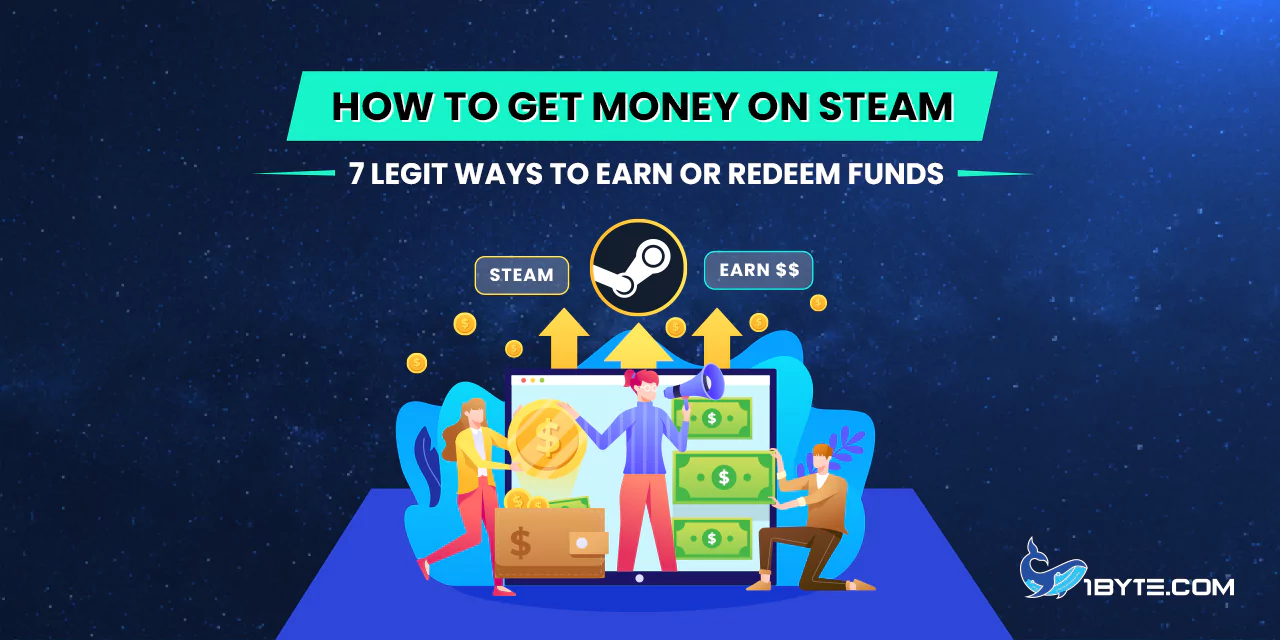- 1. Sell In-Game Items on the Steam Community Market
- 2. Sell Steam Trading Cards for Steam Wallet Credit
- 3. Redeem Steam Gift Cards or Wallet Codes
- 4. Use Online Reward Platforms to Earn Free Steam Gift Cards
- 5. Participate in Legitimate Giveaways and Contests
- 6. Leverage Microsoft Rewards for Steam Credits
- 7. Create and Sell Content on Steam (Mods, Skins, or Games)
- Conclusion
Steam is a hugely popular gaming platform with a massive user base. In fact, Steam has about 132 million monthly active users worldwide and 69 million daily users as of recent statistics. With so many gamers on the platform, it’s natural that many want to know how to get money on Steam to enhance their gaming experience. Steam uses a Steam Wallet system – a digital account for funds that can be spent on games, in-game items, downloadable content (DLC), and more. Gaining money on Steam usually means increasing your Steam Wallet balance through legitimate methods. Fortunately, there are several legit ways to earn or redeem funds on Steam. These range from selling virtual items to redeeming gift cards and taking advantage of reward programs. Each method requires some effort or creativity, but they do not involve scams or hacks (always avoid any site or person promising “free Steam money” for nothing – it’s likely a scam). Below, we at 1Byte break down seven proven ways to get Steam Wallet funds and back them up with facts, stats, and examples.
1. Sell In-Game Items on the Steam Community Market
One of the most straightforward ways to earn Steam Wallet funds is by selling in-game items on the Steam Community Market. Many games on Steam (especially Valve titles and popular multiplayer games) drop cosmetic items, skins, or other virtual goods as you play. Players can list these items for sale on the market, and other users buy them using Steam funds. When your item sells, the proceeds (minus a small transaction fee) go into your Steam Wallet for you to spend on anything on Steam.

Steam’s market ecosystem is enormous. The rarer an item and the more popular the game, the higher the potential price. While common drops might only be worth a few cents, some rare Steam items have sold for hundreds or even thousands of dollars. For example, certain CS:GO weapon skins have sold for over $750,000 in extreme cases. This shows how valuable in-game items can become in the collector market. Popular games like Counter-Strike: Global Offensive, Dota 2, PUBG: Battlegrounds, Team Fortress 2, and others have vibrant item markets where players trade skins, weapons, and cosmetic crates. Steam’s user base is so large that there’s significant demand for unique virtual items, making it possible for dedicated players to earn Steam Wallet money by trading.
To get started, a Steam user can simply check their inventory for items earned through gameplay (for instance, a rare weapon skin from CS:GO or a cosmetic drop from Team Fortress 2). These items can be listed on the Community Market directly through Steam. Once listed, other users can purchase them. For example: a player who unboxes an exotic knife skin in CS:GO could list it on the market and potentially earn tens or hundreds of dollars in Steam credit if the skin is highly sought after. The process is legit and built into Steam – users have collectively engaged in millions of item sales on the platform. Valve, the company behind Steam, takes a small cut of each transaction, but the rest goes to the seller’s Steam Wallet. This method won’t make someone rich overnight, but active trading and selling of in-game loot can steadily build up Steam funds to spend on new games or DLCs.
Tip: Keep an eye on item rarity and market trends. Items that are limited-time drops or tied to popular events can spike in value. Also, remember that Steam Wallet funds earned this way stay in Steam – you can spend them on Steam, but you cannot cash them out to real-world money through Steam. Still, if your goal is to have more money to buy Steam games, selling in-game items is one of the top legit strategies.
FURTHER READING: |
| 1. Top 5 Affiliate Marketing Websites in 2025 |
| 2. 10 Unique Business Ideas for Teens in 2025 |
| 3. 10 Best Dropshipping Products of 2025 |
2. Sell Steam Trading Cards for Steam Wallet Credit
Another legitimate method to get money on Steam is by taking advantage of Steam Trading Cards. Steam Trading Cards are virtual collectibles earned by playing many games on Steam. Each game that supports trading cards will drop a few cards (usually half a set) as you play. These digital cards feature artwork and are part of game-specific collections. While their primary purpose is for collecting and crafting badges on your profile, they have a very practical use: you can sell Steam Trading Cards on the Community Market for Steam Wallet cash.
Selling trading cards is easy and accessible to any Steam user. As you play games, you might notice card drops (Steam even allows idle play – you can leave a game running to earn its card drops). Once you receive these cards, you can go to your Steam Inventory, select the card, and put it up for sale on the market. Each trading card has a real Steam Wallet value, though most common cards only sell for around $0.05 to $0.20 (Steam takes a small fee, so you might net a few cents per card). It may not sound like much, but many gamers have dozens or even hundreds of cards sitting unused from their game library. Those small amounts can add up over time. For instance, selling 100 cards at $0.10 each could give you around $10 in Steam Wallet funds – enough for a smaller game or a good discount on a bigger title.
Some cards, such as foil cards or cards from very popular or very rare games, can fetch higher prices. For example, a foil trading card (a special shiny version) might sell for a few dollars if collectors need it to complete a badge. The key is that trading cards essentially convert your playtime into Steam money. Instead of ignoring them, savvy Steam users sell cards to build up their wallet balance.
Collecting and selling trading cards is a zero-cost method since cards drop just by playing games you already own. It’s a legit way sanctioned by Steam – in fact, Valve introduced trading cards specifically to encourage engagement and a mini-economy. According to a Lifewire tech guide, the two primary purposes of Steam trading cards are to craft badges and to create Steam Wallet funds by selling them. In other words, Valve acknowledges that many players sell cards for wallet credit, which they can then use to buy more games or in-game items.
Tip: If you have a large Steam library, consider using the “Steam Card Exchange” or simply check each game’s badge progress to see how many card drops remain. Also, Steam periodically offers booster packs (additional card drops) for users who have crafted badges or for random lucky users – these too can be sold for profit. While you won’t get rich selling trading cards (most are only worth a few cents), it’s essentially free Steam money for games you play. Many users routinely sell cards after finishing a game as a small rebate on their purchase, which over time funds new game purchases.
3. Redeem Steam Gift Cards or Wallet Codes
One of the simplest ways to get money into your Steam Wallet is by redeeming Steam Gift Cards or wallet codes. Steam gift cards are prepaid cards (digital or physical) that carry a balance, such as $20 or $50, which can be added to a Steam account. These cards are widely available – you can buy physical Steam cards in retail stores around the world, or you can receive digital gift card codes online. They work just like gift certificates, and once redeemed the amount is credited to your Steam Wallet.
If you receive a Steam gift card as a present (for example, during holidays or your birthday), redeeming it will instantly add funds to your Steam Wallet. The process is straightforward and safe. You log into Steam, go to “Add Funds to your Steam Wallet” or the gift card redemption page, and enter the code on the card. The Steam website confirms and applies the balance, which you can then spend on any purchase. According to Steam’s official description, Steam Gift Cards can be used to buy games, software, hardware, or any item on Steam – meaning they effectively translate to cash within Steam’s ecosystem.
Steam gift cards have become extremely popular globally as a way to gift gaming money. For instance, the worldwide gift card market (across all types of gift cards) reached $474 billion by 2024, and gaming cards like Steam are a significant part of that. In some regions, Steam cards are in such high demand that they even hold strong resale value. Reports have noted that Steam gift cards often retain the highest resale value among gift cards in certain markets because of their popularity with gamers. This underlines how Steam credit is nearly as good as cash for millions of gaming enthusiasts.
In practical terms, redeeming a Steam gift card is a redemption rather than earning. You either have to receive the card as a gift or spend money to buy the card first (for yourself or others). However, it’s worth mentioning because many people might have unused gift cards or account credit. It’s also common to get Steam Wallet codes from promotions or giveaways (which we will cover later). Always remember to redeem codes only on the official Steam platform. Never trust third-party sites that claim they will add money to your account if you input your login – those are scams. The only safe way to apply a Steam code is via Steam’s own website or client. Once redeemed, the funds are immediately available, and you’ll see your wallet balance updated. This method is legitimate and encouraged by Steam (Valve’s site even helps you locate retailers that sell their gift cards).
In summary, if you’re looking for how to get money on Steam and you happen to have gift cards or can ask for them as presents, redeeming those is one of the quickest legitimate ways to boost your Steam Wallet. It might not be “earning,” but it is converting funds into Steam money in a safe manner.
4. Use Online Reward Platforms to Earn Free Steam Gift Cards
Did you know you can earn Steam gift cards by completing simple online tasks or playing games on certain platforms? There are reward websites and mobile apps that give users points or credits for doing things like filling out surveys, testing apps, playing other games, watching videos, or even shopping online. Users can then redeem those points for various rewards, including Steam Wallet codes or gift cards. This is a realistic and legit way to get Steam money for free, as long as you use reputable platforms.

For example, popular “get-paid-to” (GPT) sites like Swagbucks or Freecash and gaming reward apps like Mistplay have options to redeem earnings as Steam gift cards. On these platforms, gamers earn points by completing offers or playing sponsored games, and those points can be cashed out as Steam Wallet codes. One tech writer notes that many of the best methods to get free Steam codes involve using these reward sites and apps. Some specific examples include:
- Swagbucks: Lets users earn by taking surveys, watching ads, or playing small games. You can cash out for a wide variety of gift cards, including Steam.
- Mistplay: An Android app where you earn rewards for trying out new mobile games. Mistplay points can be redeemed for Steam gift cards (among other options).
- Gamehag: A website that rewards you (with a currency called Soul Gems) for playing games and completing quests; these gems can be exchanged for Steam Wallet top-up codes or even specific Steam game keys.
- Bananatic: Similar to Gamehag, it gives tasks in games and rewards you with bananas that you can redeem for Steam prizes.
- Cash-back and shopping reward apps: Some apps or browser extensions give you cash-back on purchases which you can then redeem as gift cards (Steam included). For instance, using a cash-back platform when shopping online might net you a $10 gift card after accumulating rewards.
These methods are essentially ways to trade your time (or attention) for Steam money. They are legitimate, but you should have realistic expectations. As noted by experienced users, points can take a while to rack up on such apps. You’re doing small tasks for small rewards, so patience is key. However, if you enjoy playing a variety of games or don’t mind doing surveys in your spare time, it can be a fun way to subsidize your gaming budget. For example, one user reported earning approximately $80 in Steam credit within 3 days using a site called Freecash by testing apps and games, though results vary and one should ensure their computer’s security when downloading any apps.
Important: Stick to well-known, trusted reward platforms. There are plenty of scam sites promising free Steam money that either never pay or try to steal your information. Legitimate ones will never ask for your Steam password or anything risky – they will simply give you a code or digital gift card when you redeem your hard-earned points. Always research a site’s reputation (for instance, threads on Reddit’s /r/beermoney or /r/giftcards can provide guidance on what’s working for people). Using reputable apps like those mentioned above is safe and within the terms – for example, Swagbucks and Mistplay are widely used globally to earn gaming gift cards, and they partner with advertisers and developers, making their rewards system sustainable and legit.
In summary, online reward programs provide a viable route to get Steam funds without spending your own money. It might take some time and effort, but it’s essentially trading a bit of work or play for Steam Wallet credit. Many gamers use this strategy to afford a new game now and then or to save up for Steam sales.
5. Participate in Legitimate Giveaways and Contests
Another way to snag some Steam money is to participate in giveaways, contests, or promotions that offer Steam Wallet codes or gift cards as prizes. In the gaming community, giveaways are quite common – content creators, game developers, or community groups often host contests to boost engagement, and a frequent reward is a Steam gift card or free Steam game key. These events give participants a chance to get Steam credits without any financial cost (just the effort of entering the contest).
Giveaways can be found on various platforms: social media (Twitter, Facebook groups), streaming platforms (Twitch or YouTube gaming channels), forums like Reddit, and even on Steam’s own community hubs. For example, a popular Twitch streamer might celebrate reaching a follower milestone by giving away several $20 Steam gift cards to random viewers who enter a raffle. On Reddit, communities like r/pcgaming or r/steam sometimes have threads where generous users or sponsors drop free codes. Additionally, some tech and gaming companies run promotions – such as sweepstakes where winners get digital gift cards. According to a report on Steam free money methods, Steam giveaways and contests are common on social media and gaming forums, and many influencers or gaming communities give out gift cards or Steam codes to winners.
To take advantage of this:
- Follow gaming influencers or official game pages on platforms like Twitter. They often announce giveaways (e.g., “Retweet and follow to win a $50 Steam gift card”).
- Join Steam groups or Discord servers for games or communities you like. They sometimes host small contests or have bots that drop codes.
- Check community forums: Websites like SteamGifts.com specialize in users giving away game keys (though SteamGifts is more for games, not wallet funds, it’s still value on Steam). Also, keep an eye on Reddit sections – for instance, r/FreeGamesOnSteam often shares free game promotions, and occasionally wallet code giveaways happen in various subreddits.
- Look for events: During major sales (Summer Sale, Winter Sale), some sites or YouTubers do special giveaways in celebration.
While luck-based, participating in these events can be fun and potentially rewarding. For example: in a recent community contest, a group of gamers on Twitter ran a trivia quiz about classic Steam games, and the top three winners each received a $20 Steam code. Similarly, an e-sports tournament might give Steam credit to viewers through random drops. These are all legitimate and community-endorsed ways to get Steam money.
Word of caution: Just as with reward sites, you need to be careful. Only engage in giveaways that do not ask for sensitive personal data. A legitimate giveaway will usually only require something like a follow, a like, or an email address at most – never your Steam login or payment info. Be wary of fake “giveaways” that ask for too much or try to direct you to sketchy websites. The gaming community is generally quick to call out scams. If a contest is hosted by a known creator or brand, it’s likely safe. If it’s a random person asking you to click a strange link, think twice. When you do win a legitimate contest, the host will typically send you a Steam Wallet code or gift card code to redeem (or sometimes they might use Steam’s official digital gift card system to send funds to your account email).
In essence, joining giveaways and contests is a no-cost tactic that can result in extra Steam funds. It relies on luck, but since it costs nothing but a moment of your time, it’s a good idea to take part whenever you stumble upon a credible opportunity. Persistent members of the community often accumulate wins over time, effectively getting games or wallet credit for free.
6. Leverage Microsoft Rewards for Steam Credits
A perhaps surprising but effective method to get Steam money is by using Microsoft Rewards (formerly known as Bing Rewards). Microsoft Rewards is a program where users earn points for doing things like searching the web with Bing, answering daily quizzes, or trying Microsoft services. These points can be redeemed for various gift cards, and notably, Steam Wallet digital gift cards are often among the available reward options.
This is a completely free and legitimate program by Microsoft – essentially, Microsoft is paying you (in points) to use their search engine and services, and you can cash those points in for gaming goodies. Many gamers who are cash-strapped use this as a steady trickle of credit. For example, by making Bing your default search engine for everyday web browsing and doing a few quizzes, you might rack up enough points each month to redeem a $5 or $10 Steam gift card. It doesn’t sound like much, but over a year that’s $60-$120 in free Steam money, which could fund a couple of big games during sales.
A financial blog on modern methods to earn Steam credits mentions that Microsoft Rewards is an easy and reliable way to expand your gaming budget on Steam. Users accumulate points through routine activities and then convert them into digital gift cards. Redeeming for Steam is usually done by selecting a Steam gift card option in the Microsoft Rewards redeem page (for instance, 1,600 points might get you a $1.25 Steam card, and larger denominations scale up). The availability of Steam gift card rewards can vary by region, but it’s commonly offered in many countries. If Steam cards aren’t directly available, you could sometimes redeem for an Xbox or Microsoft gift card and use that to buy a Steam card code from the Microsoft store, but that is an extra step. Often, Microsoft Rewards has direct Steam Wallet Code redemptions which simplifies the process.
Why is this legit? Microsoft has partnerships to provide popular gift cards as redemption options for their loyalty program. It’s a win-win: users give Bing some traffic and engagement, and in return Microsoft spends some marketing budget on gift cards. Gamers benefit by getting Steam funds without spending money. A key advantage of Microsoft Rewards is that it’s passive and easy – you don’t have to go out of your way beyond doing your web searches and clicking some fun quiz questions.
To maximize this:
- Sign up for Microsoft Rewards with your Microsoft account.
- Use Bing for daily searches (there’s a cap on how many points you can earn per day from search – e.g., a certain number of points for PC searches and for mobile searches).
- Do the daily set: usually a poll, a quiz, or trivia that gives bonus points and is often related to fun facts or news.
- Check for extra activities like streak bonuses or seasonal challenges which give lumps of points.
- Once you have enough points, head to the Redeem section and choose Steam gift card of the desired amount.
Many users accumulate points over time almost without noticing, and then redeem when a Steam sale is coming up to get a free game. It’s legitimate and used by thousands of gamers. Just note that it may take a few weeks or months of consistent usage to gather a significant amount of points – but since it’s something you can do alongside your normal internet use, it’s a very low-effort method to essentially get Steam money for free.
7. Create and Sell Content on Steam (Mods, Skins, or Games)

The most involved but potentially most lucrative way to make money on Steam is to create your own content and sell it. Steam is not only a platform for playing games, but also for content creators who contribute mods, items, or even full games. If you have artistic, programming, or design skills, you can tap into this avenue. Here are a few examples of what this entails:
- Steam Workshop Creations (Mods and Items): Many games on Steam (especially Valve’s own titles like Team Fortress 2, Dota 2, CS:GO, etc.) allow community members to design cosmetic items or mods. Through the Steam Workshop, you can submit your creations (for example, a new weapon skin, a character outfit, a custom map, or a unique item). If the item is accepted and added to the game (usually via a curation process by the developers or community voting), it can be sold to players, and the creator gets a share of the revenue. This can result in real earnings deposited to your bank or Steam Wallet depending on the program. Valve reported back in 2015 that it had paid out over $57 million to Steam Workshop creators who made in-game items for TF2, Dota2, and CS:GO since 2011. That was spread among about 1,500 contributors, meaning some of the top creators earned tens of thousands of dollars each from their digital items. And that program has expanded since then – many more games now allow paid Workshop items, providing more money-making opportunities for creative Steam users.
- Game Development (Steam Direct): If you have the ability to create a game (even a small indie game), Steam Direct allows almost anyone to publish a game on Steam for a fee (around $100 per game submission). Once your game is on Steam, you earn revenue from each purchase by players (after Steam’s 30% cut). Some indie developers have made modest side income, and a few have made fortunes when their game became a hit. For example, small indie titles can sometimes sell hundreds of thousands of copies if they catch on, translating to serious revenue. While not every game will be a success, this is undeniably a legit way to make money via Steam – it’s essentially starting a small business as a game creator. As of 2025, Steam’s catalog has over 100,000 games, showing how many developers (big and small) are selling content on the platform.
- Selling Mods or Other Assets: In addition to items in big games, there have been programs (like Skyrim’s Creation Club or other curated mod marketplaces) that let modders sell high-quality mods. Also, some creators sell artwork or profile themes related to games (though these might be outside Steam’s official systems, e.g. commissioning artwork for Steam profiles on sites like Fiverr as mentioned in a budget guide). However, focusing on Steam’s built-in avenues, the Workshop is the main path for modders to monetize directly on Steam.
It’s worth noting that creating content is not an overnight process. It requires skill, time, and often collaboration. But it is the highest ceiling method. A talented artist who designs a popular skin could earn a chunk of money (Valve typically gives creators a certain percentage of each sale of their item). For instance, a Team Fortress 2 hat that becomes popular or a CS:GO skin case you contributed to can yield royalties as long as it sells. Valve’s $57 million payout by 2015 shows that real people – hobbyists and artists – have made significant money this way. And since then, even more games (including ones by other studios) have introduced paid community content, expanding opportunities for creators. The Steam Workshop model has been extended to games like Warframe, Rust, and others in various forms.
How to get started? If you have an interest in this, pick a game you love that has a Workshop and see what the contribution process is. There are usually guides for each game’s mod tools. Alternatively, if you code, consider making a simple game (game jams or using engines like Unity/Unreal with tutorials can help you produce something small). The barrier to entry is a $100 fee and the ability to make a playable game – from there, Steam gives you a platform to potentially sell it to millions of users. Keep in mind, success is not guaranteed; this route is more of a project or career than a quick tip. Yet, it is absolutely a legitimate way to earn money “on Steam” in the sense that Steam will be the marketplace that generates your revenue.
In summary, content creation on Steam – whether through modding or game development – is a valid route to make money, and it’s as “legit” as it gets since you are providing value (a game or item) in exchange for earnings. It leverages Steam’s infrastructure for distribution. For those with the passion or skills, this method can be rewarding both financially and creatively. Just remember to abide by each game’s guidelines and Steam’s rules when creating content, and be prepared to invest effort. Not everyone can or wants to do this, which is why we list it last – but it’s an important method to mention for completeness.
Leverage 1Byte’s strong cloud computing expertise to boost your business in a big way
1Byte provides complete domain registration services that include dedicated support staff, educated customer care, reasonable costs, as well as a domain price search tool.
Elevate your online security with 1Byte's SSL Service. Unparalleled protection, seamless integration, and peace of mind for your digital journey.
No matter the cloud server package you pick, you can rely on 1Byte for dependability, privacy, security, and a stress-free experience that is essential for successful businesses.
Choosing us as your shared hosting provider allows you to get excellent value for your money while enjoying the same level of quality and functionality as more expensive options.
Through highly flexible programs, 1Byte's cutting-edge cloud hosting gives great solutions to small and medium-sized businesses faster, more securely, and at reduced costs.
Stay ahead of the competition with 1Byte's innovative WordPress hosting services. Our feature-rich plans and unmatched reliability ensure your website stands out and delivers an unforgettable user experience.
As an official AWS Partner, one of our primary responsibilities is to assist businesses in modernizing their operations and make the most of their journeys to the cloud with AWS.
Conclusion
Getting money on Steam is definitely possible through a variety of legitimate methods – from simple tactics like selling your unwanted virtual items and redeeming gift cards, to more involved strategies like earning through reward programs or even creating content. The seven methods outlined above cover both earning (making Steam Wallet funds by selling or doing tasks) and redeeming (converting external rewards into Steam credit). These approaches have been used successfully by many Steam users around the world. For instance, gamers regularly sell in-game loot on the market to afford new titles, and a multitude of players have funded their Steam purchases by accumulating gift cards from survey sites or Microsoft Rewards. All of this can be done safely and within Steam’s terms of service.
A few final pointers for success: Stay safe and avoid scams. Only use trusted platforms and Steam’s official channels when money is involved. Be patient and persistent. Methods like surveys or trading require a bit of time to see significant results, but they do pay off with consistent effort. And most importantly, enjoy the process – if you’re selling items, it likely means you enjoyed the game to obtain them; if you’re earning via a rewards app, pick games or tasks that are fun for you; if you’re creating content, let it be a labor of love. By following these legit ways, anyone can boost their Steam Wallet balance and get more out of Steam without simply pulling out a credit card for every purchase. Now that you know how to get money on Steam through honest means, you can expand your game library or in-game inventory while spending little to no extra money from your pocket. Happy gaming, and happy earning!

